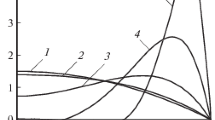Summary
A relatively simple mathematical scheme is proposed by which the entrance-region temperature solution for laminar flow heat transfer with axial conduction can be rigorously obtained.
For Poiseuille pipe flow (parabolic velocity profile) with uniform wall heat flux, the accurate first twelve eigenvalues, eigenfunctions, and the coefficients of the series expansion which are required in the temperature solution have been determined for Peclet numbers of 5, 10, 20, 30, 50, and 100. In addition, asymptotic expressions for the eigenvalues and the eigenfunction,R n (1), are derived. It is possible to use the asymptotic equation to predict, with satisfactory accuracy, even the first few eigenvalues for all the Peclet numbers considered.
By employing the computed eigenvalues and the relevant constants, the effect of axial conduction on the entrance-region temperature profile and local Nusselt numbers has been examined and reported.
Similar content being viewed by others
Abbreviations
- C :
-
specific heat at constant pressure
- C n :
-
coefficients of series expansion in Eq. (11)
- Nu :
-
Nusselt number\(\left( { = \frac{{q_w }}{{T_w - T_b }}\frac{{2r_0 }}{k}} \right)\)
- N Pr :
-
Prandtl number (=Cμ/k)
- N Re :
-
Reynolds number (=2r 0 ūρ/μ)
- Pe :
-
Peclet number (=N Re N Pr )
- R n :
-
eigenfunctions for (12) and (13)
- R n (1):
-
eigenfunction atξ=1
- T :
-
temperature
- T 0 :
-
fluid temperature forx<0
- T f :
-
fully developed temperature
- T w :
-
temperature at tube wall
- k :
-
thermal conductivity of fluid
- q w :
-
heat flux at tube wall
- r :
-
radial coordinate distance
- r 0 :
-
radius of a circular tube
- t*:
-
=T−T f
- u m :
-
maximum fluid velocity
- ū :
-
average fluid velocity
- x :
-
axial coordinate distance
- β n :
-
eigenvalues of (12) and (13)
- Δ :
-
=x/(r 0 N Re N Pr )
- η :
-
a parameter
- Θ :
-
=(T−T 0)/(q w r 0/k)
- θ :
-
=t*/(q w r 0/k)
- μ :
-
viscosity of fluid
- ξ :
-
=r/r 0
- ρ :
-
density of fluid
References
Siegel, R., E. M. Sparrow andT. M. Hallman, Appl. Sci. Res.A 7 (1958) 386.
Schneider, P. J., Trans. Am. Soc. Mech. Engrs.79 (1957) 766.
Singh, S. N., Appl. Sci. Res.A 7 (1958) 386.
Singh, S. N.,Ibid. 325.
Agrawal, H. C., Appl. Sci. Res.A 9 (1960) 177.
Pahor, S. andJ. Strnad, Appl. Sci. Res.A 10 (1961) 81.
Bird, R. B., W. E. Stewart andE. N. Lightfoot, Transport Phenomena, p. 295, Wiley, New York, 1960.
Hsu, C.-J., A.I.Ch.E. J.11 (1965) 690–5.
Sellars, J. R., M. Tribus andJ. S. Klein, Trans. Am. Soc. Mech. Engrs.78 (1956) 441.
Author information
Authors and Affiliations
Additional information
This work was performed under the auspices of the U.S. Atomic Energy Commission.
Rights and permissions
About this article
Cite this article
Hsu, CJ. An exact mathematical solution for entrance-region laminar heat transfer with axial conduction. Appl. Sci. Res. 17, 359–376 (1967). https://doi.org/10.1007/BF02116438
Received:
Issue Date:
DOI: https://doi.org/10.1007/BF02116438



